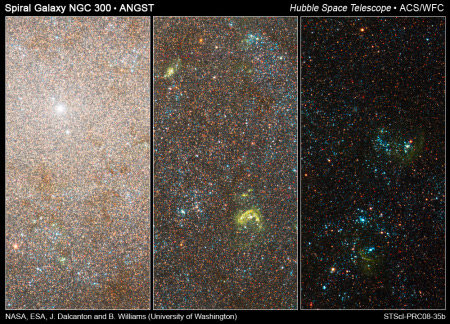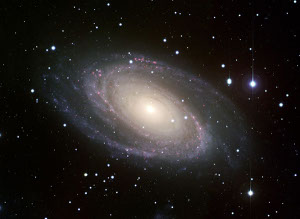Hubble’s ACS Nearby Galaxy Survey Treasury (ANGST) has everything going for it but the right acronym. One thing the spectacular images returned from this work definitely do not lead to is a deep, philosophical fear or, as ‘angst’ is defined by the American Heritage Dictionary, “A feeling of anxiety or apprehension often accompanied by depression.” Quite the contrary, the results of ANGST are all but euphoric in their celebration of stars in the galaxies we see around us, fully sixty nine galaxies in the so-called ‘Local Volume.’
The euphoria comes from Hubble’s sharp vision. The Local Volume encompasses galaxies beyond the Local Group, with distances in the survey ranging from 6.5 million light years to 13 million light years from Earth. That’s actually close enough that the right tools for seeing — Hubble’s Advanced Camera for Surveys and Wide Field Planetary Camera 2 — can pull individual stars out of what had been an indistinct galactic background. Out of that we stand to learn something about star formation in different types of galaxies.
The study ranges from galaxies in which star formation is active and ongoing to those made up entirely of ancient stars. Julianne Dalcanton (University of Washington), leader of the ANGST survey, sums up what the findings point to:
“When we look back in time at distant, young galaxies, we see lots of vigorous star formation. However, we can only guess as to what those galaxies might eventually turn into. Using the galaxies in the nearby universe as a ‘fossil record,’ we can compare them with young galaxies far away. This comparison gives us a history of star formation and provides a better understanding of the masses, structures, and environments of the galaxies.”
The image below suggests the level of detail involved. It’s a composite of three close-up views of NGC 300, a member of the Sculptor Group of galaxies.

Image: At far left, Hubble resolves a dense swarm of stars, patches of dust, and a bright central star cluster. This cluster lies at the very nucleus of the galaxy. Similar clusters are thought to be related to the formation of supermassive black holes. The image at center shows a star-forming region a few thousand light-years farther from the galaxy’s center. The yellow blobs are the glow from hot gas that has been heated by radiation from the nearest young, blue stars. The image at far right reveals more diffuse groupings of young, blue stars, farther away from the galaxy’s center, along with faint shells of hot gas. Credit: NASA, ESA, and J. Dalcanton and B. Williams (University of Washington).

Interesting in terms of astrobiology is the work on M81 that draws on data from this survey. Here I’m quoting from a Hubble news release (the relevant paper isn’t yet online), but Benjamin Williams (University of Washington) notes that stars in the outer disk of massive spiral galaxies like this one formed in the early universe. In M81’s case, we’re talking about periods of heavy star formation occurring seven billion years ago — half the current age of the cosmos. What’s intriguing here is the rapid enrichment of heavy elements via supernova explosions. Says Williams: “We were surprised by how quickly the elements formed and how the subsequent star-formation rate for the bulk of the stars in M81 changed after that.”
Image: The spiral galaxy M81. If stars in its outer disk formed seven billion years ago and the galaxy was rapidly filled with heavy elements via supernovae, could civilizations have emerged a billion or more years before our Sun even formed? Credit: Jonathan Irwin/DSS2.
There’s our old friend Fermi again, teasing us with the possibility of civilizations far more ancient than our own. The paper is Williams et al., “The ACS Nearby Galaxy Survey Treasury I. The Star Formation History of the M81 Outer Disk,” submitted to the Astronomical Journal.


Hi Paul;
This is an outstanding article.
When ever I see images of whole galaxies in sharp resolution with other objects in the background and foreground, it effects me in a deep spiritual sense. Whether or not a given individual believes in a God who created the cosmos or not, I am sure that the given individual will have a certain sense of the eternity of creation which most probably stirs within the individual a deep sense of the mystery of the existence of the cosmos. I get a deep feeling of serenity every time I see such photos, and a deep sense of the eternal also.
As to the possibility of civilizations starting 7 or 8 billion years ago, I get a feeling that even these ETI have only explored just a brief glimmer of a differential volumetric element of the cosmos, perhaps even just a glimmer of an element, dV, the big bang which cosmologists refer to as the universe.
The work of the Hubble Space Telescope is not only science, but also, art and philosophy. Every time I see a new high resolution photo taken by Hubble, I simply stare at it for several minutes. If I have family around when I am viewing the photos, even family members that are not inclined to think about interstellar travel, I usually, perhaps a little selfishly, say to them something like. “Check this out! You have got to see this Hubble Photo!” and sometimes I will persist for a few more seconds beckoning them to see the photo. They are usually totally impressed.
Thanks;
Jim
James, I share your feelings of awe, etc.
BTW, my impression of the article was not ‘civilizations starting 7 or 8 billion years ago’, but their host stars starting that long ago. Possible civs would take a bit longer to arise, but would indeed still have a headstart in comparison with us (1 – 3 billion years?).
Ronald, you’re right, the seven billion year figure is for the earliest star formation, but the work suggests that supernova activity quickly produced heavier elements. Figure four billion years for a technological society to appear (as per our experience on Earth) and that would imply there could have been such three billion years ago and perhaps earlier.
If technological civilization emerged in these places a billion years ago, we should be see some kind of artifice or something that could be artifice. A civilization a billion years old should at least encompass their entire galaxy.
It might not be obviously recognizable because for us to observe M81 is like stone-age people paddling down the Hudson river to look at NYC. However, if such a civilization exists, we should observe something about M81 that does not fit with entirely natural explanation.
No doubt a billion year old civilization is going to be as far beyond us as we are beyond single-celled algae. It is likely they have become post-physical, in the transhumanist sense. Maybe the unexplained “dark” matter or energy is the artifice of such an advanced civilization.
November 25, 2008
Unusual Red Spiral Galaxies “Strangled”
Written by Nancy Atkinson
Images of three galaxies from the Galaxy Zoo (top) and STAGES surveys (bottom) show examples of how the newly discovered population of red spiral galaxies on the outskirts of crowded regions in the Universe may be a missing link in our understanding of galaxy evolution.
Usually a galaxy’s shape corresponds with its color as well as its age. Spiral galaxies appear blue because they are still dynamically forming hot young stars. Elliptical galaxies, on the other hand, are mostly old, dead, and red.
But surprisingly, two international collaborations have both separately identified a population of unusual red spiral galaxies. Galaxy Zoo, which uses volunteers from the general public to classify galaxies and the Space Telescope Galaxy Evolution Survey (STAGES) project have found that many of the red galaxies in crowded regions of galaxy clusters are actually spiral galaxies, bucking the trend for red galaxies to be elliptical in shape.
However, these galaxies might be in transition, going from young to old, slowly having the life ‘choked’ out of them.
“We think what we’re seeing is galaxies that have been gently strangled, so to speak,” said Chris Lintott, Galaxy Zoo team leader from University of Oxford, “where somehow the gas supply for star formation has been cut off, but that they’ve been strangled so gently that the arms are still there.”
Sounds like a CSI murder mystery, but in this case astronomers are studying the scene of the crime.
Full article here, with links to the relevant papers:
http://www.universetoday.com/2008/11/25/unusual-red-spiral-galaxies-strangled/